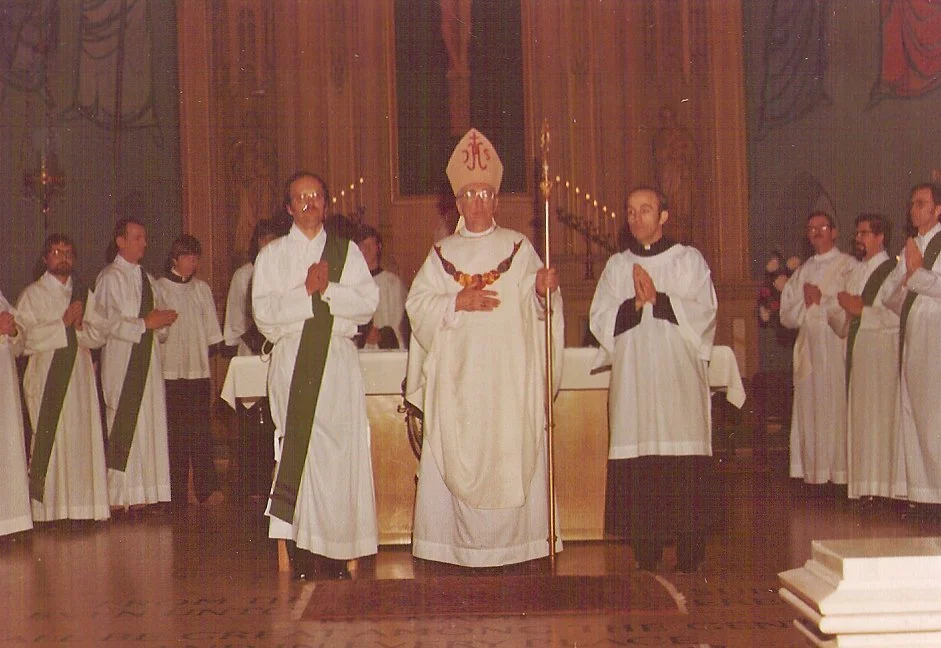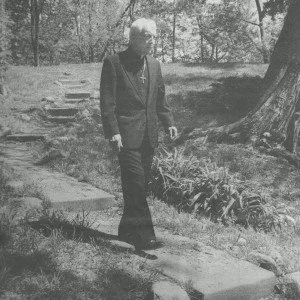Most Reverend Edward W. O'Rourke, D.D.
Sixth Bishop of Peoria, 1971-1990
The Most Reverend Edward W. O’Rourke, D.D. was thefFirst native son to hold the office of Bishop of his diocese. Born October 31, 1917, on his family's farm near Downs. One of eleven children of Martin and Mary Hickey O'Rourke, founding members of St. Mary Parish in Downs.
At the age of 13, on the night of his confirmation in 1930, he became convinced of his vocation to the priesthood, and for the rest of his life "never had a moment of doubt that this was my calling." He was ordained May 28, 1944, by Bishop Schlarman in St. Mary Cathedral in Peoria.
Fr. O’Rourke surely did not know that his first assignment of assistant chaplain at the Newman Foundation at the University of Illinois in Champaign would last sixteen years.
From 1948 to 1955 he also served as diocesan director of resettlement for displaced persons fleeing the communist takeover of Eastern Europe, finding homes and jobs for hundreds of such refugees.
In June 1960 he was named executive director of the National Catholic Rural Life Conference. For the next eleven years he helped establish hundreds of economic development committees, cooperatives and other self-help programs in the U.S. and abroad. He lectured widely on his experiences in developing countries, traveling more than 140,000 miles to nineteen nations in one year alone.
Named as Sixth Bishop of Peoria
On June 1, 1971, he was named bishop of Peoria to succeed the retiring Bishop John B. Franz. At his installation Mass on July 15, he set the tone of his episcopacy by challenging himself and his flock to "extend comfort to all who are lonely, broken-hearted or in pain ... strive to reconcile those who are alienated and restore economic dignity and security to those who are poor." He was known as a champion of rural life, social justice and simple living.
Several months later, he demonstrated his commitment by selling the Bishop's Mansion on Glen Oak Avenue, moving into a one-bedroom brick ranch near St. Mary Cathedral, and depositing the money from the sale into the retired priests’ fund. He received national attention also as an advocate of simple living following an editorial he wrote on the subject for The Catholic Post in 1974.
First Diocesan Class Ordination of Permanent Deacons
Bishop O’Rourke reorganized the diocese into 15 vicariates, replacing the old system of six deaneries. He ordained the diocese's first class of permanent deacons in 1976 and launched the Teens Encounter Christ program and retreats for widowed and divorced.
He made international headlines in 1976 when he was aboard a New York to Chicago TWA flight hijacked and diverted to Paris by Croatian nationalists. He led the passengers in prayer and tried to persuade the hijackers to give themselves up during the 32-hour ordeal, which ended with the hijackers surrendering to French police.
In 1986, he established the Annual Stewardship Appeal (now know as the Annual Diocesan Appeal) and a diocese-wide policy for marriage preparation that remains in effect, with some modifications, to this day.
In his 1993 pastoral letter "Jesus the Divine Teacher" he proposed five new mysteries of the rosary focusing on Christ's public life. Eventually, three of these appeared in the new Luminous Mysteries of Pope St. John Paul II.
Despite a number of health problems, he maintained a large garden and gave away produce he couldn't use to his neighbors, friends and the needy.
In 1987 Father John J. Myers, his Vicar General, was appointed coadjutor bishop with right of succession. After Bishop O'Rourke announced his retirement in January 1990, Bishop Myers succeeded him as Ordinary, and Bishop O'Rourke moved to the St. Augustine Manor retirement residence in Peoria.
Retirement
A few months later, Bishop O'Rourke founded Renaissance Stand, an organization designed to help the long-term unemployed obtain jobs and job training. He devoted much of his days to the volunteer organization's work. "I've been all over the world," he said in 1996, six years after his retirement and 25 years after becoming bishop. "But now I will concentrate on this one section of Peoria where I live and make it my responsibility." He continued to tend his vegetable garden until failing health forced him to give up such activity.
Following his death on September 29, 1999, at age 81, his funeral drew thousands to St. Mary Cathedral, including those he had helped find jobs, homes or other assistance. He was buried in the Bishop's Mausoleum at St. Mary Cemetery in Peoria. His tomb is inscribed with the epitaph "Friend of the Poor”.





